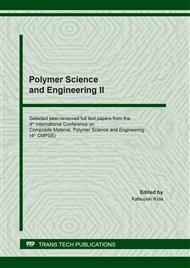p.3
p.9
p.15
p.23
p.29
p.37
p.43
p.49
Lossy Titanite-Based Ceramics with Nominal Compositions CaTi1-xMySiO 5 (0 ≦ X, Y ≦ 1, M = Mn, Sn, Zr, Nb) Applicable to Millimeter Electromagnetic Wave Absorber
Abstract:
The titanite-based ceramics with nominal composition CaTi1-xMySiO5 (0≦x≦1, M = Mn, Sn, Zr (y = x), and M = Nb (y = 4x/5)) in which part x of Ti sites are replaced by several kinds of atoms had remarkable increase in both the real and imaginary parts of complex relative permittivity around x = 0.0125~0.1 compared with those of pure titanite CaTiSiO5 ( x = 0) at 70 GHz. Real part varied from 3 to 43, and the imaginary part from 0 to 12 (tangent delta from 0 to 0.28). No reflection condition is fulfilled for M = Zr when x = 0.05, d/λ0 =0.042, and for M = Nb in both cases when 0 < x < 0.0125, d/λ0 = 0.05 and 0.1 <x < 0.2, d/λ0 =0.042, where d is thickness of the plate sample and λ0 is the wavelength of incident electromagnetic wave. The dominant dielectric dispersion may occur due to difference of ionic polarization between Ti4+ ions and Mn4+, Sn4+, Zr4+, or Nb5+ ions relative to O2- ions, which becomes inactive and saturates around x = 0.0125~0.05. From the measurement of the lattice parameters, a, b, c, and the angle β, characterizing monoclinic crystal structure, this saturation may have close correlation with some structural rearrangement of constituting atoms, Ti and substituted M atoms in CaTi1-xMySiO5
Info:
Periodical:
Pages:
9-14
Citation:
Online since:
June 2021
Authors:
Price:
Сopyright:
© 2021 Trans Tech Publications Ltd. All Rights Reserved
Share:
Citation:


